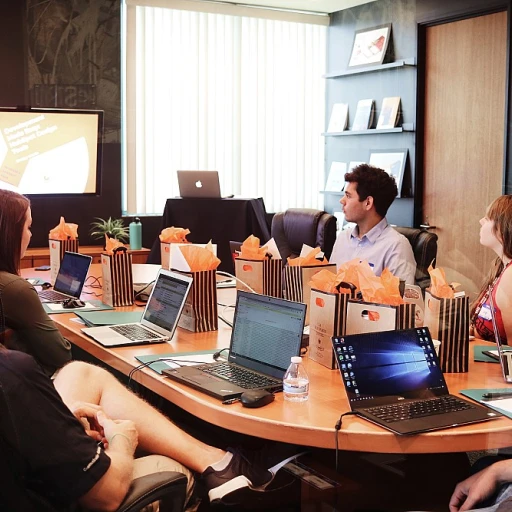The Role of Ice Breakers in Employee Engagement
Understanding the Power of Initial Interactions
Ice breakers play a significant role in fostering employee engagement by creating a comfortable environment for team members to connect. Whether it's during team meetings or in virtual setups, these simple yet effective activities help in breaking down barriers. As teams are often diverse, comprising individuals with different backgrounds and personalities, icebreakers can level the playing field, enabling everyone to participate actively.
Engaging team building activities, including icebreaker questions, have proven to be a great tool for initiating conversation and establishing rapport among team members. These exercises are not about just being a 'nice-to-have'; they are strategically aimed at enhancing the team's cohesiveness. An icebreaker question can stimulate those initial interactions that pave the way for deeper connections.
For employees, especially new ones, feeling part of the group is essential for their productivity and job satisfaction. Icebreakers, when thoughtfully incorporated, can become an integral part of team-building exercises, encouraging fun and openness, which are crucial for a healthy workplace environment. Furthermore, icebreakers help individuals to understand their colleagues better—what are their favorite movies or the funniest thing they did with kids in their free time—which can improve teamwork and resilience in the long term.
Ultimately, the aim of using ice breakers is not just to fill time or to entertain but to lay a foundation for effective communication and collaboration. Structured correctly, these activities are more than a mere icebreaker; they can be the best form of engagement, paving the way for exceptional team dynamics, and ensuring everyone looks forward to coming to work every day. The goal is to make the team feel heard, valued, and ready to contribute their best to the team's mission.
Crafting the Perfect Ice Breaker Questions
Creating Engaging Questions for Team Ice Breakers
Crafting the perfect ice breaker questions is a crucial step in ensuring successful team building and enhancing employee engagement. The right questions can set a positive tone and foster a sense of camaraderie among team members. Here are some strategies to consider when developing these questions.
- Know Your Audience: Understand the characteristics of your team. Are you addressing fresh graduates, experienced professionals, or a mix of both? Their background will inform whether icebreaker questions should lean towards fun or more professional topics.
- Balance Fun and Work: While funny icebreaker questions can lighten the mood, it's equally important to include questions that relate to work experiences. Questions like, "What is your favorite thing about the past year at work?" can be both engaging and relevant.
- Encourage Interaction: Design questions that encourage team members to interact with one another. For instance, "What’s a movie that represents your life story?" helps people get personal and opens up avenues for conversation in virtual meetings as well.
- Personal and Professional Blend: Integrating both personal and work-related questions can keep the dialogue dynamic. For example, "What's a fun or interesting thing you're learning currently, at work or outside?" introduces a casual yet insightful topic into discussions.
Ultimately, the best icebreaker questions are those that resonate with your team members, promoting a welcoming atmosphere that aligns with the overall aim to enhance engagement and create lasting connections.
Implementing Ice Breakers in Team Meetings
Making Ice Breakers Part of Your Meeting Routine
Implementing ice breakers in team meetings is an effective way to bolster employee engagement without taking much out of your schedule. The best icebreaker questions allow team members to connect on a personal level, fostering an environment of trust and camaraderie. First, consider the structure of your meeting. Incorporating icebreakers early in the meeting can set a positive tone, break down barriers, and make people more comfortable sharing their thoughts. It doesn’t need a massive time commitment; sometimes just a few fun questions can do the trick to get everyone talking and laughing together.- Balance Work and Fun: While your primary goal is team building and enhancing work productivity, a fun icebreaker like "What is your favorite movie of all time?" or "What's the best thing you’ve tried this year?" can lighten the atmosphere. Questions involving personal interests or fun facts are great for decreasing formality.
- Rotate Facilitation: Encouraging different team members to lead each icebreaker session can promote leadership skills and give everyone a stake in the activity's success. This practice diversifies the questions and incorporates multiple perspectives.
- Regularly Update Your Icebreakers: Keep your sessions fresh by varying the questions. Consider using themes relevant to different times of the year, or tweak the activities to reflect current events or team milestones.
Virtual Ice Breakers for Remote Teams
Embracing Virtual Ice Breakers for Remote Teams
In today's digital age, remote work is more prevalent than ever, making virtual ice breakers an essential tool for team building. These activities help bridge the gap between team members who may never meet in person, fostering a sense of connection and camaraderie. But how do you effectively implement icebreaker questions in a virtual setting?
First, consider the platform you're using. Whether it's Zoom, Microsoft Teams, or any other virtual meeting tool, ensure that everyone knows how to use the features necessary for the ice breaker. This might include breakout rooms, chat functions, or reaction emojis. A quick tech check at the start can save time and ensure everyone can participate.
Next, choose questions that are engaging and inclusive. Good icebreaker questions for virtual teams often revolve around personal favorites or hypothetical scenarios. For example, asking team members about their favorite movie or the best thing they've learned this year can spark lively discussions. These questions work well because they are easy to answer and allow people to share a bit of their personality.
Incorporating a mix of fun and thoughtful questions can also help. Funny icebreaker questions can lighten the mood and make the meeting more enjoyable, while more serious questions can provide deeper insights into team dynamics. For instance, asking "If you could only eat one type of cuisine for the rest of your life, what would it be?" is a fun way to get to know your team members better.
For teams with diverse backgrounds, consider including questions that are culturally sensitive and inclusive. This ensures that everyone feels comfortable and valued, which is key to successful team building.
Lastly, don't forget to consider the timing. Virtual meetings can be draining, so keep the ice breaker short and sweet. A 5-10 minute activity at the start of the meeting can be just enough to energize the team without taking away from the main agenda.
By thoughtfully incorporating virtual ice breakers, you can help build stronger connections and enhance engagement, even from a distance.
Measuring the Impact of Ice Breakers on Engagement
Evaluating the Success of Icebreakers in Team Dynamics
Incorporating icebreakers such as carefully considered questions and activities into team meetings can provide both immediate and long-lasting benefits when effectively measured. The primary aim is to enhance engagement and foster a sense of connection among team members. But how can one assess the actual impact of these icebreaker initiatives?- Participant Feedback: Gathering input from team members after meetings can offer valuable insights. Ask questions like, "What was your favorite icebreaker question?" or "How did the activity affect your perception of the team?" These responses can inform whether the icebreaker achieved the desired outcome, be it increased camaraderie or simply a bit of fun.
- Engagement Levels: Monitor changes in engagement throughout the year. Increased participation in discussions or a willingness to communicate openly are strong indicators of effective icebreakers.
- Productivity Metrics: Compare productivity before and after integrating icebreaker questions. If team member output improves, it may suggest that team building through icebreakers positively influenced a work environment conducive to performance.
- Team Morale: Regular assessment of team morale can reflect the influence of good icebreakers. This can be done through short pulse surveys focused on fun and enjoyment levels during team interactions.
- Retention Rates: High employee retention rates can be indirectly linked to increased engagement through team-building activities. Employees who feel connected and valued are more likely to stay with the company.












